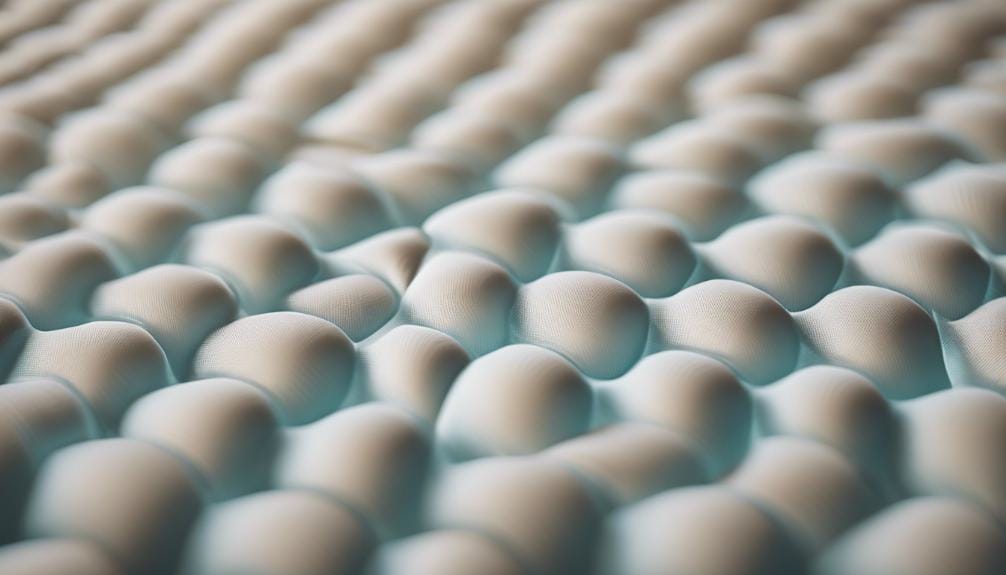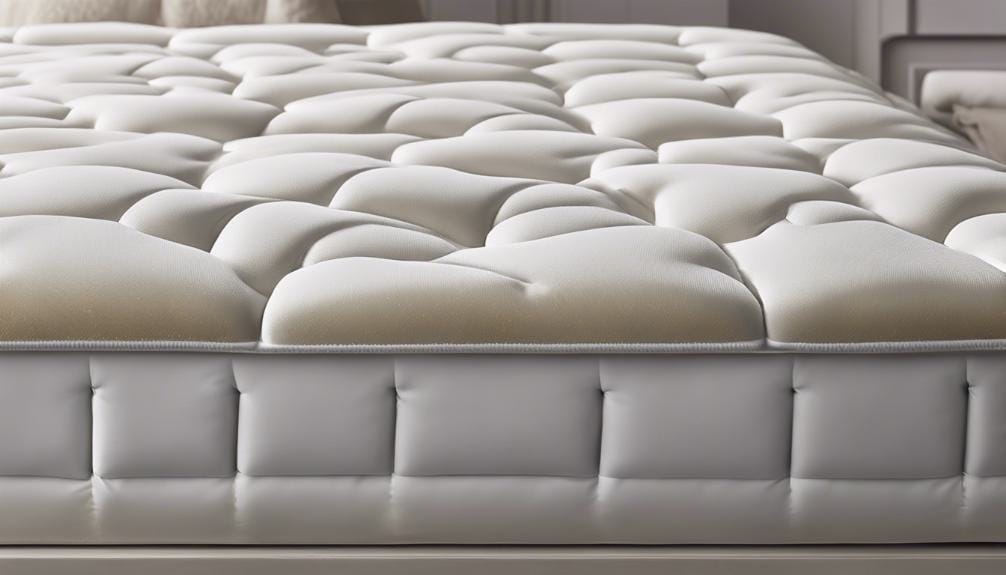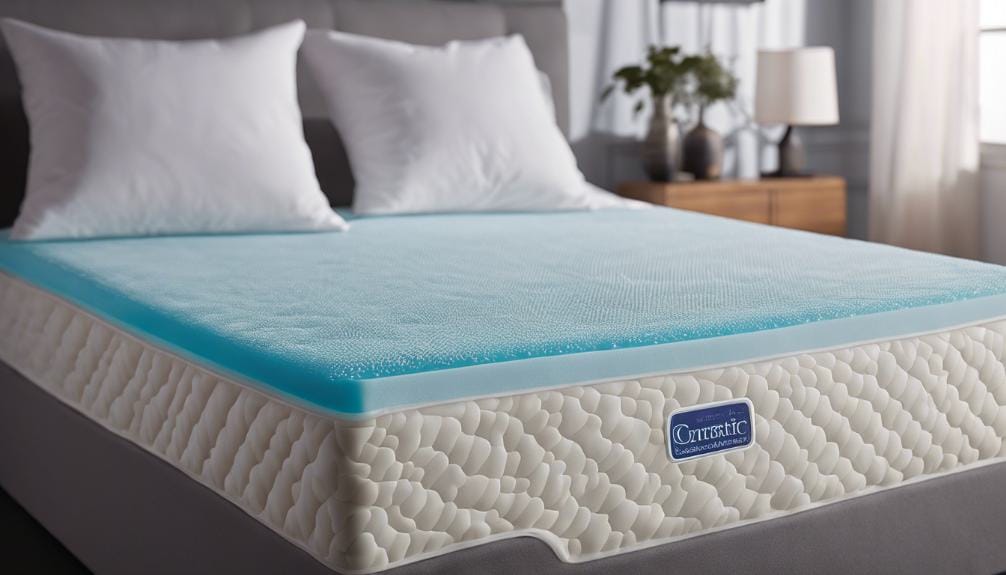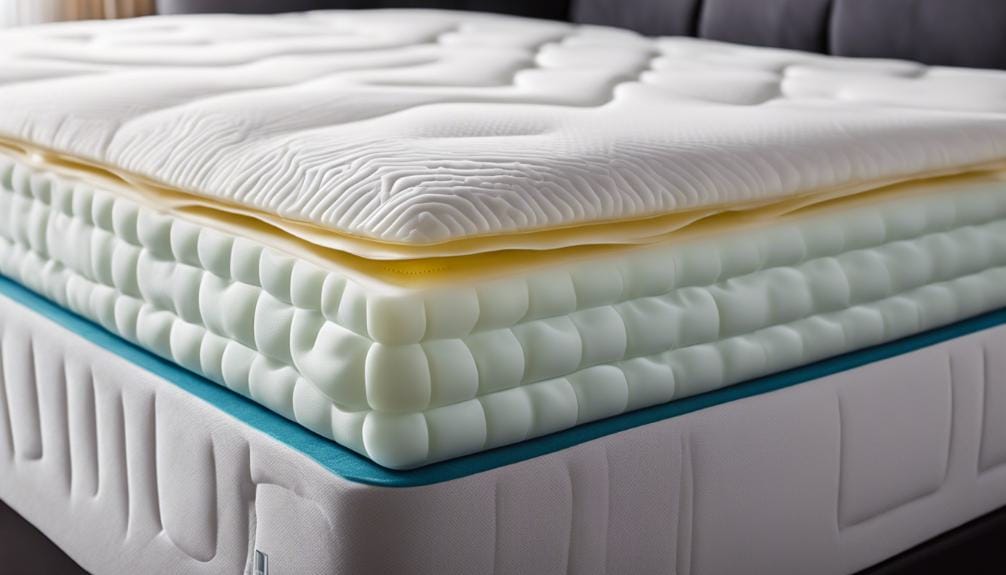Is Mattress Topper Good for Back Pain? Exploring the Benefits and Drawbacks
If you’re battling back pain, a mattress topper can be a great ally. It helps align your spine, reduce pressure points, and improve sleep quality. Choosing the right one, like memory foam or latex, can offer relief and comfort. The key lies in finding the perfect firmness and thickness to suit your needs. Mattress toppers enhance spinal alignment and decrease muscle tension, leading to better rest. For more insights on types, considerations, and expert tips for back pain relief, dive deeper into the benefits and top recommendations.
Benefits of Using Mattress Toppers
A high-quality mattress topper significantly improves sleep quality and reduces back pain.
Memory foam mattress toppers, which are highly recommended, provide strong support, helping to align the spine and lessen pressure points. This is crucial for people who suffer from back pain.
These toppers also enhance the comfort and firmness of your bed and are available in hypoallergenic options, promoting a restful, pain-free sleep.
They cater to various sleeping preferences, making them a versatile addition to any bedding setup.
Types of Mattress Toppers for Back Pain
When choosing a mattress topper to ease back pain, it’s important to know the different types available to best suit your needs. Memory foam mattress toppers contour to your body and help relieve pressure. Polyfoam is more affordable and offers good compression, which can be beneficial for back support. Latex toppers provide buoyant support, which can be helpful for keeping the spine aligned. Microcoil toppers, similar to hybrid mattresses, provide robust support and help regulate temperature, which can improve sleep quality.
Selecting the right material is crucial not only for comfort but also for the topper’s longevity and effectiveness in alleviating back pain. Each material has its benefits, so consider what best matches your specific pain relief needs and personal preferences.
Choosing the Right Material

To effectively alleviate back pain, choosing the right material for your mattress topper is crucial. Memory foam and natural latex are top recommendations. These materials are known for their ability to distribute weight evenly, relieve pressure points, and provide durable support, making them ideal for individuals dealing with back pain.
Investing in high-quality memory foam or latex can significantly improve your sleep quality by ensuring robust back support and pain reduction. Studies and user reviews frequently highlight the benefits of using these materials in mattress toppers for enhanced comfort and spinal alignment. Choose wisely to experience lasting relief and comfort.
Factors to Consider for Back Pain Relief
To effectively alleviate back pain, it’s critical to choose a mattress topper with the right firmness, thickness, and ability to relieve pressure. Prioritizing support, cushioning, and proper spinal alignment is key. Memory foam and latex are preferred materials because they conform to the body’s shape, providing essential support and reducing pressure points.
Here’s a comparison of popular types of mattress toppers:
| Firmness Level | Thickness | Support |
|---|---|---|
| Memory Foam | 3 inches | Excellent |
| Latex | 2 inches | Good |
| Gel-infused | 4 inches | Moderate |
Memory foam toppers, at 3 inches thick, offer excellent support and are highly effective for back pain relief. Latex toppers, slightly thinner at 2 inches, also provide good support and are more responsive than memory foam. Gel-infused toppers, while thicker at 4 inches, offer moderate support and are better for temperature regulation.
Selecting a topper that suits your specific needs can significantly improve your sleep quality and reduce back discomfort.
Top Mattress Toppers for Back Pain

Exploring the best mattress toppers for back pain relief, various innovative features and materials stand out for their ability to improve sleep quality and reduce discomfort. Nolah’s memory foam toppers and organic latex options like the Best Hypoallergenic Mattress Topper provide effective pressure relief. The Saatva Graphite Mattress Topper is known for its firm support. Additionally, products like Woolroom’s The Wooly Mattress Topper, Tuft & Needle Foam Mattress Topper, and Lucid Down Alternative and Gel Memory Foam Mattress Topper address different aspects of back pain relief.
These toppers use materials and technology backed by research to offer support and comfort. Memory foam, for instance, conforms to the body’s shape to reduce pressure points, as noted in various sleep studies. Organic latex is praised for its durability and natural hypoallergenic properties. The inclusion of graphite in some toppers helps dissipate heat, which can improve sleep quality by keeping the sleeper cool. Each of these options caters to specific needs, helping to ensure that individuals with back pain can find a topper that suits their requirements.
How Mattress Toppers Help Back Pain
Mattress toppers can significantly improve back pain by adding extra cushioning and support to your bed. These toppers are designed to help maintain proper spinal alignment, which is crucial in alleviating back discomfort. By evenly distributing your body weight, they minimize pressure points and lessen muscle tension. This contributes to a noticeable improvement in sleep quality, which is essential for effective pain management and overall health.
Here’s how mattress toppers assist in reducing back pain:
- Support: They enhance spinal alignment.
- Pressure Relief: They decrease muscle tension.
- Comfort: They improve sleep quality.
Best Type of Topper for Relief

To alleviate back pain, choosing the right mattress topper is crucial. Memory foam toppers are effective as they contour to the body and relieve pressure points. Latex toppers, being responsive and naturally pressure-relieving, are also a good choice.
For those on a budget, polyfoam toppers offer similar contouring benefits. Microcoil toppers, which are similar to hybrid mattresses, help with temperature control and provide additional support.
When selecting a topper, it’s important to consider its firmness, the materials used, and its cooling features to ensure optimal comfort and support.
Key Considerations When Buying
When buying a mattress topper to ease back pain, it’s crucial to focus on the firmness level. This ensures the topper provides the right support.
Memory foam or latex are top choices as they reduce pressure points and maintain proper spinal alignment.
The thickness of the topper also plays a significant role in overall comfort and effectiveness.
For those who tend to overheat while sleeping, opt for a topper with cooling features to maintain comfort throughout the night.
Expert Recommendations for Back Pain

Expert recommendations often stress the importance of using mattress toppers for back pain relief. These toppers provide essential support and comfort. When choosing a mattress topper specifically for back pain, consider material and firmness. Both memory foam and latex are effective choices. Memory foam aligns the spine and increases comfort, while latex helps in reducing pressure points and enhancing support.
According to various health sources, including physical therapists, adding a mattress topper can significantly improve sleep quality and aid in managing back pain. This is because the right topper can transform an unsupportive mattress into one that better suits the body’s natural posture and sleeping style.
Physical therapists particularly endorse mattress toppers as a practical intervention to improve sleep and reduce discomfort. When selecting a topper, it’s crucial to opt for one that matches your specific needs in terms of firmness and material to effectively address back pain.
Testing and Trusting Mattress Toppers
When assessing mattress toppers, prioritize factors such as comfort, support, durability, and breathability. Here’s a practical guide to testing and trusting mattress toppers:
- Sleep Position Performance: It’s crucial to evaluate how the topper performs under various sleep positions. According to sleep studies, a mattress topper should support the natural curve of your spine, regardless of whether you sleep on your side, back, or stomach.
- Firmness for Support: Look for a topper with a firm build. A firm mattress topper can provide the necessary support for your spine, which may help in reducing back pain. The Sleep Foundation notes that proper spinal alignment is key to a good night’s sleep.
- Recovery from Compression: Check how well the mattress topper bounces back after being compressed. A good quality topper will return to its original shape quickly, maintaining its supportive features over time.
Frequently Asked Questions
Would a Mattress Topper Help With Back Pain?
Adding a mattress topper may assist with back pain by providing extra support and cushioning. It can improve spinal alignment, reduce pressure points, and promote better sleeping posture, potentially easing discomfort and enhancing your sleep quality.
What Thickness of Mattress Topper Is Best for Back Pain?
For back pain relief, the best thickness of a mattress topper depends on personal factors such as body weight and mattress firmness. Opt for 2 to 4 inches for cushioning and support, or thicker for better contouring and pressure relief.
What Mattress Topper Do Chiropractors Recommend?
Chiropractors often recommend latex mattress toppers for their buoyant and responsive nature, providing balance, structure, and cushioning for spinal support. Choose high-quality options like Dunlop or Talalay variations for long-lasting relief and proper alignment.
What Type of Mattress Is Recommended for Back Pain?
For back pain, consider a medium-firm memory foam or latex mattress. These types offer support and comfort to aid spinal alignment. Look for motion isolation to prevent disturbances. The best mattress choice can reduce pressure points and improve sleep quality.
Conclusion
If you have back pain, adding a mattress topper might help. These toppers can increase support and comfort, which may reduce your pain and improve your sleep.
It’s important to choose a topper made of the right material and design for your needs. Experts often have recommendations on the best options to try.
Testing different mattress toppers can help you find the one that works best for you. A good mattress topper can make a big difference in easing your back pain and enhancing the quality of your sleep.
